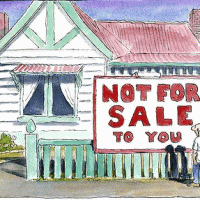European Murder Rates Compared to the United States: Demographics vs Guns
February 3, 2014
The housing question that the Senate must address
February 3, 2014For the last couple of years I have been receiving emails from Jewish sources that proclaim that anti-Semitism is rampant in Europe and that half of French Jewry is about to emigrate to Israel. This is a reflection of their victim mentality and the mind-set of “us against them,” the concept that anti-Semitism will always separate us from the rest of humanity. Now comes Daniel Goldhagen, a controversial academic, with his new book, “The Devil That Never Dies: The Rise and Threat of Global Antisemitism,” which puts an academic gloss upon the hysteria.
This is not to deny that there is a rise in anti-Semitism in parts of Europe, especially in Hungary, which I will discuss in this column; but it is a far cry from what the online Tablet magazine, in its review of the Goldhagen book, declared, “A New Era of Anti-Semitism Is Here.”
First let us begin with the United States. For the last two decades studies have been showing a diminution of anti-Semitism in this country, yet many Jewish organizations have been wary of the data. The coup de grace was delivered two years ago by Robert Putnam and David Campbell in their universally acclaimed study of religion in America, “American Grace.”
They devised a “feeling thermometer” study in which they asked different religious groups what they thought of other religious communities. Their findings show that Jews were the highest ranked, the most respected and accepted, along with Mainstream Protestants and Catholics.
The fact that we are warmly accepted in American society should not surprise anyone, despite our being bombarded by money-raising scare tactics by the Anti-Defamation League (ADL) and other “defense organizations.” Our prominence in politics, our acceptance through intermarriage, and our entrance into the highest echelons of American business reflect this reality.
Yet within the last decade an American Jewish Committee (AJC) poll showed that 97% of American Jews believed that anti-Semitism was either a very serious problem (37%), or somewhat of a problem (60%), and 49% believed that it was increasing. Thus the perception of the Jewish community did not reflect reality. It appears that American Jews are still traumatized by the history of anti-Semitism in this county in the first half of the 20th century. It may take another couple of generations to cleanse us of this victim mentality.
Now what about Europe? This past November the Institute for Jewish Policy Research (JPR), based in the U.K., published a survey of European anti-Semitism for the European Agency for Fundamental Rights. They canvassed almost six thousand Jews in nine countries, utilizing eleven different languages. It is the largest study ever of Jews in Europe. The study asked Jews of their perceptions of anti-Semitism in their respective countries. Not surprisingly, the memory of the Holocaust in Europe looms larger to them than American Jewish memory of the anti-Semitic 1920’s and 1930’s in America.
In an introduction to the study, Jonathon Boyd, the executive director of the JPR, writes: “In any assessment of European Jewish life today, we should be cognizant of the extent to which our perspective is clouded by the shadow of this relatively recent history.” Given that caveat, the study still does not support the hysteria of my emails or the Goldhagen book.
The study does show that European Jews perceive an increase in anti-Semitism, but it is not of epidemic proportions and neither is it universally rising. Each country has its own story, but Boyd links anti-Semitism with the rise in Europe of antipathy to minorities due to integration of populations as a consequence of the European Union.
He writes: “The integration question is very complex: as the population becomes more mixed and heterogeneous, the character of national identity changes, rendering it both harder to determine what binds one citizen to another and increasing the likelihood of internecine conflict.” The conclusion is that anti-Semitism may be rising, at least in the perception of Jews themselves, which is not always accurate, but it is not an exclusive Jewish problem. It is a reflection of a broader societal problem.
This study repudiates Goldhagen’s thesis that this rise reflects an almost pathological prejudice that spans centuries and cultures, which makes it unique to Jews and impossible to eradicate. His conclusion would reinforce the classic Zionist thesis that negates the Diaspora and that all Jews should make aliyah to Israel for their long-range safety.
The JPR study shows that for Western Europe anti-Semitism is episodic and correlated to events in the Middle East. After the Israeli invasion of Gaza in 2009 (Operation Cast Lead) anti-Semitism increased. By 2011 anti-Semitic incidents had decreased. In Eastern Europe, especially in Hungary, anti-Semitism is not so much linked to the Middle East as to rising nationalism and fear of minorities.
But even in Hungary the study shows that Jews feel very much a part of Hungarian culture. Three percent emigrated and returned, but 48 percent reported that they have considered emigrating, but it is a long distance from thought to action. On the whole, for the entire continent the majority of Jews has never contemplated leaving Europe. This is in contrast to the hysterical emails that claim that half of French Jewry is packing its bags.
Definitely, Europe is not the United States which prides itself on a polyglot, multi-racial, multi-religious and multi-cultural society — so one would expect a more complex situation there concerning anti-Semitism. But Chicken Little is not prancing around and the sky is not falling.
Boyd summarizes the contradictory situation well: “In essence, we have data that indicates life is becoming increasingly uncomfortable for Jews in Europe, and data that indicates that Jewish life remains quite secure.”
The real challenge for the communal future of the 1.4 million European Jews is demographics. Death rates are consistently higher than birth rates, and that inevitably leads to population decline. But this is also cloudy since there is no consensus of who is a Jew. As one example, Jewish population estimates for Hungary range from 48,000 to 160,000 depending upon who is included and excluded.
Putting aside the shadow of the Holocaust and misperceived perceptions, but accepting the reality of some uptick in anti-Semitism, the future vitality of European Jewry remains primarily dependent on long-term demographics. However, this is difficult to ascertain. Boyd writes: “There is little empirical basis upon which to develop an educated view.”
But European Jews are there and thriving, and according to the data, they intend to remain there. Boyd’s final comment on the JPR study reminds Americans: “The Jewish world is not binary, and ‘American Jewry’ does not equal ‘Diaspora Jewry’; indeed, part of the beauty and value of Diaspora is the diversity that exists within it.”
Rabbi Warshal is the publisher emeritus of the Jewish Journal and the author of “Provocative Columns: A Liberal Rabbi Reflects on Beliefs, Israel American Politics.” He can be reached at brucewarshal@comcast.net.



